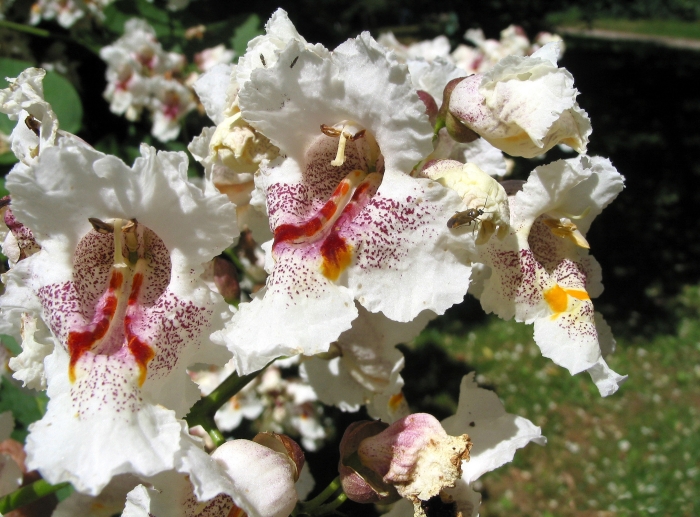Northern Catalpa
(Catalpa speciosa)
Northern Catalpa (Catalpa speciosa)
/
/

Jean-Pol GRANDMONT
CC BY-SA 2.5
Image By:
Jean-Pol GRANDMONT
Recorded By:
Copyright:
CC BY-SA 2.5
Copyright Notice:
Photo by: Jean-Pol GRANDMONT | License Type: CC BY-SA 2.5 | License URL: https://creativecommons.org/licenses/by-sa/2.5 | Uploader: Jean-Pol GRANDMONT | Publisher: Wikimedia Commons | Title: Catalpa_speciosa_JPG01b.jpg | Notes: User created page with UploadWizard |

































































































Estimated Native Range
Summary
Catalpa speciosa, commonly known as Northern Catalpa, is a deciduous tree native to the floodplains, riverbanks, and open woodlands of the east-central United States. It can grow to a height of 60 feet (18 meters) and a width of 20-50 feet (6-15 meters), with a broad, irregular crown. The tree is notable for its large, heart-shaped leaves and showy clusters of white flowers with yellow and purple markings that bloom in late spring to early summer. The flowers are followed by long, slender seed pods that persist into winter, adding visual interest. Northern Catalpa is valued for its rapid growth, tolerance of urban pollution, and use as an ornamental shade tree in large spaces.
Northern Catalpa thrives in full sun to part shade and prefers moist, well-drained soils but can adapt to a range of soil conditions, including those with poor drainage. It is relatively low-maintenance once established and can be used in urban landscapes, as a specimen tree, or for reforestation projects. While it is resistant to most pests and diseases, it can be susceptible to verticillium wilt and catalpa sphinx moth caterpillars. Gardeners should be cautious about planting it outside its native range due to its potential invasiveness, as it can spread aggressively in some regions.CC BY-SA 4.0
Northern Catalpa thrives in full sun to part shade and prefers moist, well-drained soils but can adapt to a range of soil conditions, including those with poor drainage. It is relatively low-maintenance once established and can be used in urban landscapes, as a specimen tree, or for reforestation projects. While it is resistant to most pests and diseases, it can be susceptible to verticillium wilt and catalpa sphinx moth caterpillars. Gardeners should be cautious about planting it outside its native range due to its potential invasiveness, as it can spread aggressively in some regions.CC BY-SA 4.0
Plant Description
- Plant Type: Tree
- Height: 40-70 feet
- Width: 20-40 feet
- Growth Rate: Rapid
- Flower Color: White
- Flowering Season: Summer
- Leaf Retention: Deciduous
Growth Requirements
- Sun: Full Sun, Part Shade
- Water: Medium, High
- Drainage: Fast, Medium
Common Uses
Bee Garden, Bird Garden, Butterfly Garden, Deer Resistant, Drought Tolerant, Fire Resistant, Hummingbird Garden, Salt Tolerant, Showy Flowers
Natural Habitat
Floodplains, riverbanks, and open woodlands
Other Names
Common Names: Catawba , Hardy Catalpa , Western Catalpa , Bois Chavanon , Cigar Tree , Westlicher Trompetenbaum , 미국개오동
Scientific Names: Catalpa speciosa , Catalpa bignonioides var. speciosa , Catalpa cordifolia
GBIF Accepted Name: Catalpa speciosa (Warder ex Barney) Warder ex Engelm.